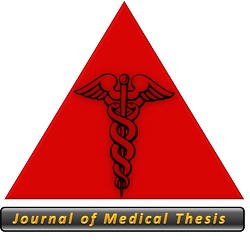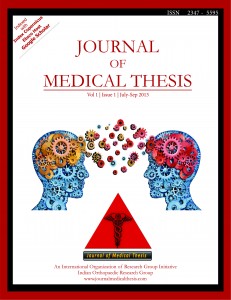Tag Archives: Tibial plateau fracture
Functional Outcomes of Tibial Plateau Fractures Treated with Various Modalities: A Prospective Observational Study
Vol 11 | Issue 1 | January-June 2025 | page: 25-27 | Shankha Subhra Datta, Sachin Kale
https://doi.org/10.13107/jmt.2025.v11.i01.240
Author: Shankha Subhra Datta [1], Sachin Kale [1]
[1] Department of Orthopaedics, Dr. DY Patil Hospital, Nerul, Navi Mumbai Maharashtra, India.
Address of Correspondence
Dr. Shankha Subhra Datta,
Department of Orthopaedics, Dr. DY Patil Hospital, Nerul, Navi Mumbai Maharashtra, India.
E-mail: shankhasubhraicare@gmail.com
Abstract
Aims: Tibial plateau fractures are complex injuries of the proximal tibia that compromise joint function and stability. This study aimed to evaluate the functional outcomes of tibial plateau fractures managed by various modalities and to correlate these outcomes with fracture classification.
Methods: In this prospective observational study, 32 adult patients with closed tibial plateau fractures were enrolled between 2019 and 2021. Fractures were classified using the Schatzker and AO/OTA systems. Management included open reduction and internal fixation (ORIF), percutaneous fixation, or conservative treatment. Functional outcomes were assessed using the Rasmussen score over a six-month follow-up.
Results: The mean age was 40.4 years, with males comprising 87.5% of the cohort. Schatzker type II fractures were most common (31.25%). Twenty-six patients (81.25%) were treated operatively. At six months, 81.25% of patients had good to excellent outcomes. Complications were minimal and included superficial infections in three cases. No deep infections, nonunions, or implant failures were observed.
Conclusion: Tibial plateau fractures treated with appropriate surgical methods and early rehabilitation yield favorable functional outcomes. The fracture type and method of fixation significantly influence prognosis. Precise classification and patient-tailored treatment remain critical.
Keywords: Tibial plateau fracture, Schatzker classification, Rasmussen score, Internal fixation, Functional outcome.
Introduction
Tibial plateau fractures involve the articular surface of the proximal tibia and are commonly caused by high-energy trauma [3]. These fractures can result in joint instability [2], malalignment, and degenerative changes if not managed properly. The goal of treatment is to restore joint congruity, stability, and range of motion.
Classification systems such as Schatzker [1] and AO/OTA [4] facilitate treatment planning. Although open reduction and internal fixation (ORIF) is widely practiced [5], the role of minimally invasive and conservative techniques remains relevant depending on the fracture type and patient profile.
This study aimed to assess functional outcomes following various treatment strategies and to correlate these outcomes with fracture patterns.
Methods
Study Design and Setting
A prospective observational study was conducted at D Y Patil Hospital, Nerul, Navi Mumbai, Maharashtra from June 2019 to May 2021.
Inclusion Criteria
• Patients aged ≥18 years
• Closed tibial plateau fractures
• Willingness to participate and complete follow-up
Exclusion Criteria
• Open or pathological fractures
• Polytrauma or neurovascular injury
• Pre-existing joint pathology
Fracture Classification
Each case was classified using:
• Schatzker Classification: Types I to VI
• AO/OTA Classification: 41-B and 41-C subtypes
Treatment Modalities
• Operative: ORIF using lateral or dual plating, or percutaneous screw fixation
• Non-operative: Long leg cast with non-weight-bearing for stable, undisplaced fractures
Outcome Measures
Clinical and radiological outcomes were evaluated using the Rasmussen score at 6 months, which grades outcomes as excellent, good, fair, or poor based on pain, walking ability, range of motion, and alignment.
Results
Patient Demographics
• Total patients: 32
• Mean age: 40.4 years
• Males: 28 (87.5%)
• Most common mechanism: Road traffic accidents (71.9%)
Fracture Patterns
• Schatzker Type II: 10 patients (31.25%)
• Types I, III, IV, V, VI accounted for the remainder
• AO/OTA distribution mirrored complexity, with most fractures falling under 41-B3
Treatment Distribution
• Operative management: 26 patients (81.25%)
• Conservative: 6 patients (18.75%)
Functional Outcomes (Rasmussen Score at 6 months)
• Excellent: 18 patients (56.25%)
• Good: 8 patients (25%)
• Fair: 4 patients (12.5%)
• Poor: 2 patients (6.25%)
Complications
• Superficial surgical site infection in 3 patients (managed conservatively)
• No deep infections, implant failures, or malunions reported
Discussion
This study demonstrated favorable functional outcomes following operative management of tibial plateau fractures, particularly when anatomical reduction and early mobilization were achieved. The predominance of Schatzker type II fractures aligns with previous epidemiological data.
Rasmussen scoring provided a robust clinical metric for evaluating outcome [2]. The minimal complication rate highlights the safety and efficacy of surgical management, although it is contingent on patient selection and surgeon expertise.
The use of classification systems supported treatment planning and prognostication, validating their continued relevance in clinical practice.
Limitations
• Small sample size
• Short follow-up duration (6 months)
• Single-center design
Further multi-centric studies with longer follow-up are needed to evaluate long-term joint function and development of post-traumatic arthritis.
Conclusion
Tibial plateau fractures managed with appropriate surgical intervention and early rehabilitation result in satisfactory functional outcomes. Classification-guided treatment strategies and individualized patient care are critical for optimal recovery.
References
1. Schatzker J, McBroom R, Bruce D. The tibial plateau fracture. Clin Orthop Relat Res. 1979;(138):94–104.
2. Rasmussen PS. Tibial condylar fractures: Impairment of knee joint stability as an indication for surgical treatment. J Bone Joint Surg Am. 1973;55(7):1331–1350.
3. Marsh JL, Slongo TF, Agel J, et al. Fracture and dislocation classification compendium. J Orthop Trauma. 2007;21(Suppl 10):S1–S133.
4. Barei DP, Nork SE, Mills WJ, Henley MB, Benirschke SK. Complications associated with internal fixation of high-energy bicondylar tibial plateau fractures. J Orthop Trauma. 2004;18(10):649–657.
5. Rademakers MV, Kerkhoffs GM, Sierevelt IN, Raaymakers EL, Marti RK. Operative treatment of 109 tibial plateau fractures: Five- to 27-year follow-up results. J Orthop Trauma. 2007;21(1):5–10.
| How to Cite this Article: Datta SS, Kale S | Functional Outcomes of Tibial Plateau Fractures Treated with Various Modalities: A Prospective Observational Study | Journal of Medical Thesis | 2025 January-June; 11(1): 25-27. |
Institute Where Research was Conducted: Department of Orthopaedics, Dr. D.Y. Patil University School of Medicine, Nerul, Navi Mumbai, Maharashtra, India.
University Affiliation: Dr. D.Y. Patil University, Nerul, Navi Mumbai, Maharashtra, India.
Year of Acceptance of Thesis: 2021
Full Text HTML | Full Text PDF




